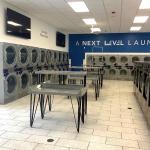OSHKOSH, Wis. — A growing number of vended laundries offer full-service wash-dry-fold and/or residential/commercial laundry services. And for good reason. Through this diversification of services, laundries can better penetrate their demographic and geographical service area for additional revenue and profit!
But, to do it well, planning is essential. So, if your goal is to develop or renovate a vended laundry — and design it to maximize full-service work — peruse these additional planning tips before jumping in:
Consider Investing in a Flatwork Ironer — An ironer quickly and automatically irons bed sheets, pillowcases and table linens, allowing your laundry to service bigger accounts that require high-quality linen finishing. Look for a compact ironer that is simple to operate with a wax-less design. For example, Continental Express Ironers properly finish linens without the need for dryer conditioning or messy wax application and removal. They automatically iron linens straight from the washer — eliminating any dryer time — using two operators. Bypassing the dryer step also boosts laundry productivity and reduces gas and electricity consumption.
Maximum Efficiency — The cost of natural gas reached its highest point last year since 2008, according to the U.S. Energy Information Administration (EIA). In Southern California, gas prices just jumped 315 percent, making it the biggest increase yet. So, it remains imperative to plan for maximizing efficiency.
Ozonation — One way to do this is through ozone. Ozone is a gas that, when injected into the wash cycle, sanitizes laundry; activates wash chemistry; relaxes fibers for improved removal of dirt, stains and grease; and works best in cool water. It reduces fabric wear and lowers utility costs. While ozone cuts gas bills and provides sanitization (a big plus for customers), it can also damage certain types of washers. So, be sure the equipment you choose is ozone-compatible.
High-Speed Washers — A second way to reduce gas costs is by choosing high-speed, soft-mount washers that produce extract speeds between 350 and 450 G-force. High-speed machines remove more moisture from laundry during extract, which cuts resulting drying time by up to 50% or more. And, since dryers consume loads of natural gas, high-speed washers also drastically cut natural gas costs. A side benefit? Customers complete laundry faster.
The Impact of Pickup And Delivery — Determine if your services will include pickup and delivery based on your demographic. This service is a fast-growing trend sparked by dual-income households and the recent pandemic. It also helps protect you in the event there’s another pandemic and the self-service side of your business gets shut down. Analyze your service area and keep it relatively tight to start to ensure gas and labor costs don’t eat away profit. You’ll need trained employees and a delivery vehicle. Start with a few customers or key commercial accounts and improve processes as you grow. Your POS system should help you manage and track every order.
Consult Your Equipment Distributor Early On — Good equipment distributors are familiar with their local vended laundry market and can lead you through the laundry planning process. Be sure to discuss your goals related to full-service work well ahead of time and visit laundries that do it well.
Miss Part 1? You can read it HERE
Have a question or comment? E-mail our editor Bruce Beggs at [email protected].






